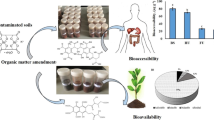Abstract
A series of batch experiments were conducted to observe the variations of bioavailability of naphthalene in different types of soil with indigenous microorganisms. Solid phase microextraction (SPME) was employed to estimate the bioavailability of naphthalene in the soils. Various soil properties were attained by artificially modifying soil organic matter (SOM) with the addition of bagasse compost and textures with the addition of original silt and clay to determine the correlation between the amount of biodegraded naphthalene after 300 h and the amount of extractable naphthalene by SPME. Experimental results indicated that the biodegradation rate increased from 0.30 (sandy loam) to 0.48 (silty loam) μg g−1 h−1 when soils had more silt/clay. In contrast, the biodegradation rate slightly decreased from 0.30 (1.3% SOM) to 0.20 (5.2% SOM) μg g−1 h−1 when the SOM was high. Distributions of naphthalene in soils after biodegradation were affected by the addition of bagasse compost. It showed that the bioavailability of naphthalene in soils decreased with an increase in SOM. Sequestration as measured by ultrasonic extractability evidently occurred within 4 months in aged soil samples. However, the amounts extracted by sonication after 4 and 16 months of aging did not statistically differ from each other. The SPME measurements correlated well with the amount of biodegraded naphthalene by indigenous microorganisms. Results of this study demonstrate that SPME is a promising method to estimate the bioremediation efficacy of naphthalene-contaminated soils with various properties.





Similar content being viewed by others
References
Ai J (1997a) Headspace solid-phase microextraction. Dynamics and quantitative analysis before reaching a partition equilibrium. Anal Chem 69:3260–3266
Ai J (1997b) Solid-phase microextraction for quantitative analysis in nonequilibrium situations. Anal Chem 69:1230–1236
Alexander M (1995) How toxic are toxic chemicals in soil? Environ Sci Technol 29:2713–2717
Arthur CL, Pawliszyn J (1990) Solid phase micro extraction with thermal desorption using fused silica optical fibers. Anal Chem 62:2145–2148
Bergknut M, Sehlin E, Lundstedt S, Andersson PL, Haglund P, Tysklind M (2007) Comparison of techniques for estimating PAH bioavailability: uptake in Eisenia fetida, passive samplers and leaching using various solvents and additives. Environ Pollut 145:154–160
Cam D, Gagni S (2001) Determination of petroleum hydrocarbons in contaminated soils using solid-phase microextraction with gas chromatography-mass spectrometry. J Chromatogr Sci 39:481–486
Chung N, Alexander M (2002) Effect of soil properties on bioavailability and extractability of phenanthrene and atrazine sequestered in soil. Chemosphere 48:109–115
Cornelissen G, Rigterink H, Ferdinandy MMA, van Noort PCM (1998) Rapidly desorbing fractions of PAHs in contaminated sediments as a predictor of the extent of bioremediation. Environ Sci Technol 32:966–970
Cornelissen G, Rigterink H, Hulscher DEM, Vrind BA, van Noort PCM (2001) A simple tenax extraction method to determine the availability of sediment sorbed organic compounds. Environ Toxicol Chem 20:706–711
Cuypers C (2001) Bioavailability of polycyclic aromatic hydrocarbons in soils and sediments. Ph.D. Thesis, Wageningen University, Wageningen, The Netherlands
Cuypers C, Pancras T, Grotenhuis T, Rulkens W (2002) The estimation of PAH bioavailability in contaminated sediments using hydroxypropyl-beta-cyclodextrin and triton X-100 extraction techniques. Chemosphere 46:1235–1245
Hall JA, Mailloux BJ, Onstott TC, Scheibe TD, Fuller ME, Dong H, DeFlaun MF (2005) Physical vesus chemical effects on bacterial and bromide transport as determined from on site sediment column pulse experiments. J Contam Hydrol 76:295–314
Hendriks J (2003) Possible application of solid phase micro extraction for determination of pesticide availability in sediment. Master Thesis, Wageningen University, Wageningen, The Netherlands
Kelsey JW, Kottler BD, Alexander M (1997) Selective chemical extractants to predict bioavailability of soil-aged organic chemicals. Environ Sci Technol 31:214–217
Lei L, Suidan MT, Khodadoust AP, Tabak HH (2004) Assessing the bioavailability of PAHs in field-contaminated sediment using XAD-2 assisted desorption. Environ Sci Technol 38:1786–1793
Mahadevan B, Marston CP, Dashwood WM, Li Y, Pereira C, Baird WM (2005) Effect of a standardized complex mixture derived from coal tar on the metabolic activation of carcinogenic polycyclic aromatic hydrocarbons in human cells in culture. Chem Res Toxicol 18:224–231
Maier RM, Pepper IL, Gerba CP (2000) Environmental microbiology. Academic Press, New York
Mayer P, Vaes WHJ, Wijnker F, Legierse KCHM, Kraaij RH, Tolls J, Hermens JLM (2000) Sensing dissolved sediment porewater concentrations of persistent and bioaccumulative pollutants using disposable solid-phase microextraction fibers. Environ Sci Technol 34:5177–5183
Mott SC, Groenevelt PH, Voroney RP (1990) Biodegradation of a gas oil applied to aggregates of different sizes. J Environ Qual 19:257–260
Nam K, Chung N, Alexander M (1998) Relationship between organic matter content of soil and the sequestration of phenanthrene. Environ Sci Technol 32:3785–3788
Nikiema J, Bibeau L, Lavoieb J, Brzezinski R, Vigneux J, Heitz M (2005) Biofiltration of methane: an experimental study. Chem Eng J 113:111–117
Parkerton TF, Stone MA, Letinski DJ (2000) Assessing the aquatic toxicity of complex hydrocarbon mixtures using solid phase microextraction. Toxicol Lett 112:273–282
Pawliszyn J (1997) Solid phase microextraction: theory and practice. Wiley-VCH, New York
Reid BJ, Stokes JD, Jones KC, Semple KT (2000) Nonexhaustive cyclodextrin-based extraction technique for the evaluation of PAH bioavailability. Environ Sci Technol 34:3174–3179
Tang J, Petersen EJ, Huang Q, Weber W (2007) Development of engineered natural organic sorbents for environmental applications: 3. Reducing PAH mobility and bioavailability in contaminated soil and sediment systems. Environ Sci Technol 41:2901–2907
Tang J, Petersen EJ, Weber W (2008) Development of engineered natural organic sorbents for environmental applications: 4. Effects on biodegradation and distribution of pyrene in soils. Environ Sci Technol 42:1283–1289
Zhang X, Young LY (1997) Carboxylation as an initial reaction in anaerobic metabolism of naphthalene and phenanthrene by Sulfidogenic consortia. Appl Environ Microbiol 63:4759–4764
Acknowledgments
The authors would like to thank the National Science Council of Taiwan, for financially supporting this research under Contract no. NSC 95-2221-E-241-010. Ted Knoy is appreciated for his editorial assistance.
Author information
Authors and Affiliations
Corresponding author
Rights and permissions
About this article
Cite this article
Liu, HC., Hwu, CS., Chu, KC. et al. Estimation of bioavailability and potential risks of naphthalene in soils with solid phase microextraction. World J Microbiol Biotechnol 26, 1311–1316 (2010). https://doi.org/10.1007/s11274-009-0302-1
Received:
Accepted:
Published:
Issue Date:
DOI: https://doi.org/10.1007/s11274-009-0302-1




